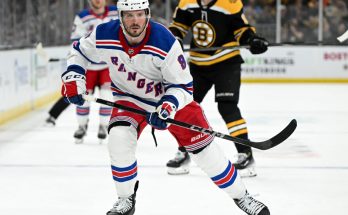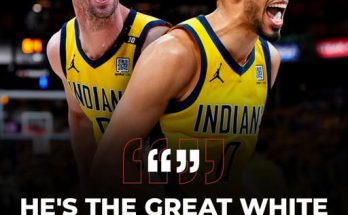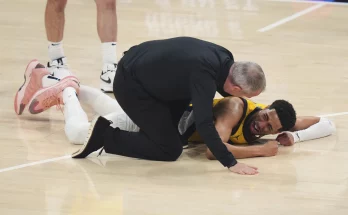The Los Angeles Dodgers, a franchise built on elite depth and relentless postseason expectations, might be facing another major blow to their pitching staff. According to team sources and postgame remarks from manager Dave Roberts, hard-throwing left-handed reliever Tanner Scott is “most likely” headed to the injured list with what’s being described as a left forearm issue—a term that has become synonymous with caution, anxiety, and, all too often, season-altering diagnoses. While the Dodgers are known for their cautious approach to injuries, especially among pitchers, the tone and urgency in Roberts’ comments suggest this is not your average precautionary stint. It’s another gut punch for a team trying to hold the line in a tightly contested National League race, and it couldn’t come at a worse time.
Tanner Scott was acquired with hopes of being a high-leverage lefty option out of the bullpen, bringing with him a wicked fastball-slider combination that has overpowered hitters for years. His performance with the Miami Marlins last season and early this year with the Dodgers cemented his value as a trusted arm in tight games. But forearm issues in a pitcher—especially a reliever who relies heavily on high-velocity pitches and hard breaking balls—often raise red flags around the dreaded specter of UCL injuries, which are frequently precursors to Tommy John surgery.
Scott had shown no outward signs of trouble until recently. Over his last few appearances, his command seemed slightly off, and his velocity dipped a touch—not unusual signs late in the season, but enough to trigger some internal concern. When Scott came out of his most recent outing grimacing slightly and immediately consulted with the training staff, the dugout reaction told a deeper story. Roberts was quick to point out that “it didn’t look good” and that while the club is “still waiting on final imaging results,” all signs point toward a stint on the injured list to allow for rest and further evaluation. The term “most likely” used by Roberts carries an unspoken weight: it means they’re hoping for the best but bracing for something much worse.
The Dodgers are no strangers to injury woes this season, particularly with their pitching corps. Already stretched thin due to injuries to starters like Walker Buehler, Dustin May, and the managing of rookie Bobby Miller’s workload, Los Angeles has relied on a patchwork rotation and an ever-rotating bullpen. Scott was one of the constants. He’s posted a sub-2.50 ERA this season, demonstrating a veteran calm and toughness in some of the team’s biggest moments. His absence could have cascading consequences for how the Dodgers structure their bullpen in late innings, especially against tough left-handed hitters that Scott was brought in specifically to neutralize.
Pitching coach Mark Prior and the Dodgers’ analytics team have been vigilant about pitch counts and usage patterns, and Scott has not been overworked relative to league norms. Yet, arm fatigue and tendon stress are cumulative, and even the most cautious approach can’t always prevent injury. The concern is whether this injury will linger beyond a couple weeks and into the months where Los Angeles needs every arm firing on all cylinders. Should it result in a longer absence, the front office—led by Andrew Friedman—may be forced to accelerate trade deadline plans or elevate lesser-tested arms into more demanding roles.
Internally, the Dodgers could lean more on Alex Vesia, who has had a rollercoaster season, or give increased responsibilities to younger relievers like Nick Ramirez or Bryan Hudson. But none of those options replicate what Scott offers: a proven, late-inning lefty who can match up against elite left-handed bats and also hold his own against righties thanks to improved command and pitch sequencing. For a team with eyes on another deep October run, losing Scott for any significant time complicates everything.
The injury also shines a spotlight on the fragility of major league bullpens, especially in an era where teams increasingly rely on matchup-based strategies and bullpen games. The Dodgers have embraced this model, sometimes out of necessity and sometimes by design, but when one domino falls, others are forced to bear more weight. Scott’s availability helped preserve the workloads of right-handed high-leverage arms like Evan Phillips and Brusdar Graterol. With his absence, more pressure shifts to those pitchers, potentially increasing their injury risk as well.
There’s also the mental impact. Teammates were visibly shaken by Scott’s early exit from his most recent outing. Clayton Kershaw, no stranger to battling through injuries, said after the game that “anytime you see a guy like Tanner go down, especially with something in the forearm, your heart skips a beat. He’s a big part of what we’re doing here. We’re all pulling for him.” Kershaw’s comments reflect the gravity of the situation—players understand the fine line between health and long-term absence in professional baseball, especially with pitching.
Fans, too, are left holding their breath. Social media lit up with speculation, frustration, and support for Scott as word spread about the potential injury. Dodgers fans, passionate and informed, know what a left forearm injury might signal. And given the team’s recent history of major arm injuries, from Tony Gonsolin to May to Buehler, it’s impossible to ignore the pattern and feel a sense of déjà vu. Scott’s contributions may not always steal headlines, but fans who watch every game understand his importance.
As for Scott himself, he’s expected to undergo further testing in Los Angeles, including an MRI that will determine the extent of any ligament damage or muscular strain. The hope is that it’s merely inflammation or a mild strain—something that a short IL stint and rest can repair. But until results are made public, uncertainty will hover. Scott has been through injuries before, and he’s battled his way back stronger, but this one carries heavier implications because of timing and team context.
The Dodgers have weathered storms before, and their player development pipeline remains among the best in baseball. If Scott does go down for an extended period, it wouldn’t be surprising to see a name emerge from Triple-A who captures attention in late-season games. That’s how the Dodgers roll—next man up, development never stops. But in a bullpen already operating with little margin for error, Tanner Scott’s loss is a critical hit.
The team’s front office now faces a difficult decision. With the trade deadline looming and uncertainty about Scott’s recovery timeline, do the Dodgers get aggressive in the trade market to secure another lefty? Names like Tanner Rainey of the Nationals or Sam Moll of the Reds have been floated as possibilities. But any move would come with a cost, and Friedman is never one to overpay unless it’s absolutely necessary. If Scott is projected to return within a few weeks, the team might opt for internal solutions. But if it’s longer—or if the worst-case scenario of a UCL tear materializes—then external reinforcements will almost certainly be pursued.
Ultimately, what makes this situation especially frustrating is how well Scott had fit in with the Dodgers’ culture and system. His transition from Miami was smooth, his production immediate, and his chemistry with teammates evident. For all the big-name stars that fill the Dodgers’ roster, it’s players like Scott—reliable, professional, and tough—that often make the difference in close playoff games. Losing him, even temporarily, reshapes the bullpen blueprint.
There’s still hope. Not every forearm issue leads to major surgery. Not every IL stint derails a season. But for now, the Dodgers are staring down the barrel of yet another pitching challenge, and it’s a reminder that in baseball, success often hinges not just on talent and strategy, but on timing and health. Tanner Scott’s injury may not be the headline moment of the season, but its ripple effects could be profound. All anyone in Los Angeles can do now is wait for the results—and brace for what might come next.



